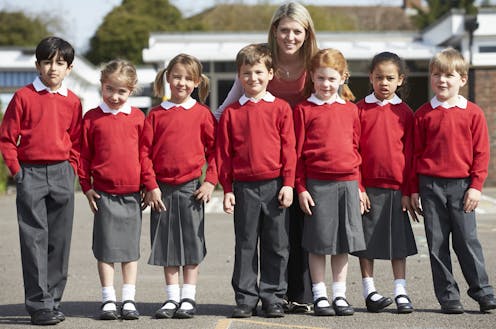Source: The Conversation (Au and NZ) – By Rachele Sloane, Graduate Researcher and Tutor – Master of Education, Student Wellbeing Specialisation (MGSE), The University of Melbourne

Shutterstock
New Child Safe Standards come into effect in Victoria this Friday, July 1. The set of 11 standards builds on the original seven. One significant change was made with little fanfare: well-being was included alongside safety as a key responsibility of organisations working with children and young people.
This change acknowledges growing community expectations and the shift toward a wellness-focused culture. Well-being is often discussed as self-evident.
Indeed, the new standards themselves do not provide a clear definition of well-being. Nor are they clear about associated expectations of what good practice looks like in schools and other educational settings.
Read more:
After years of COVID, fires and floods, kids’ well-being now depends on better support
Given these standards will amount to a requirement, organisations will need clear direction on how to meet their obligations in regard to well-being.
Well-being is a complex and multifaceted concept. Some researchers have even characterised it as a wicked problem. To meet this new responsibility to support, develop and provide for children and young people’s well-being, schools and educational settings in particular need to understand what this actually means.
Why have the standards changed?
Victoria’s Child Safe Standards recognise the vulnerability of children and young people and the responsibility of adults to help keep them safe. The standards have been in place since January 2016.
The Royal Commission into Institutional Responses to Child Sexual Abuse presented its final report in December 2017. The Victorian government then reviewed the standards and made several recommendations to strengthen the standards and align them more closely with the national principles for child-safe organisations. The primary focus during this time was on safety.
In recent years, interest in the concept of well-being has exploded, particularly with the impacts of COVID-19 on children and young people. Research and debate on well-being have burgeoned.
The Commission for Children and Young People (CCYP) assists organisations to adhere to the Child Safe Standards. This has involved developing and embedding in practice the policy and procedures that support children’s safety.
The commission continues to provide guidance on the new standards. However, the concept of well-being has not been explicitly discussed or defined.
So what exactly is well-being?
Well-being is a term that seems simple enough on the surface and yet evades clear definition. It’s often defined as the subjective experience of quality of life. It is frequently linked to mental health, and in education is often conflated with attendance and behaviour.
The World Health Organization speaks about health as being more than merely the absence of illness. Its definition includes holistic well-being across multiple domains of functioning, but stops short of nominating a single definition of well-being itself.
The well-being of children and young people specifically is more complex still. As a concept, their well-being has been discussed simply as relating to mental health through to more complex understandings as an antidote to poor behaviour and as the key ingredient of positive outcomes.
The concept of youth well-being is so complex that there are increasing attempts to formally define it through conceptual framing. This framing is useful in drawing together knowledge from across disciplines and aspects of physical, mental and social health, along with subjective experience of life, behaviour and skills.
The problem remains that this framing doesn’t give us a concise and practical working definition. This may be because well-being itself is understood differently depending on the context and community in which it is being discussed.
Read more:
Students’ well-being must always be the priority. Here are 5 tips to help them through lockdown
What does this mean for education institutions?
This idea of including well-being in education is of course not new. Evidence to support the benefits of including well-being as an educational outcome has grown steadily over the past two decades.
Well-being has been included in Australia’s educational goals in successive policy directives. It’s reflected in growing numbers of focused programs targeted at schools.
Schools are already working to support student well-being through promotion, prevention and intervention. Unfortunately, definitions of well-being vary widely between policies and programs. The complexity and inconsistency of the concept and how to achieve it continue to create significant challenges.
This is reflected in the findings of a recent study of school principals in New South Wales and in the recommendations to come out of the Royal Commission into Victoria’s Mental Health System. These difficulties suggest schools are overwhelmed with choice and need greater support to select evidence-based programs that are shown to be effective.
Including well-being in the new Child Safe Standards requires schools to focus on well-being. They must now take on an increased responsibility to care not only for student safety but also their well-being.
Schools will have to revise and develop policy in ways that acknowledge the importance and complexity of well-being. They will need to engage thoughtfully with this concept.
As the standards have not defined the term, schools will need to conceptualise this concept for their context. This means drawing together and making explicit all the aspects that the school community understands as well-being. That’s likely to cover health, skills and capabilities, behaviours and subjective experiences.
Policymakers need to provide greater conceptual clarity to support schools in this important work.
![]()
Rachele Sloane receives an Australian Research Training Program Scholarship to support her Doctoral research at The University of Melbourne – Melbourne Graduate School of Education.
Annie Gowing does not work for, consult, own shares in or receive funding from any company or organisation that would benefit from this article, and has disclosed no relevant affiliations beyond their academic appointment.
– ref. Schools will now be required to support well-being, but the standards aren’t clear on what that means – https://theconversation.com/schools-will-now-be-required-to-support-well-being-but-the-standards-arent-clear-on-what-that-means-185861







